In Edible City – Part 1, my report on an exhibition about the urban environment and its food systems, i was talking to Debra Solomon, curator of the show and author of Culiblog, about utopian projects. This second part will focus more on some recent or ongoing proposals and strategies to produce food in or near the city. Debra listed all the projects on her blog but here’s a quick selection:
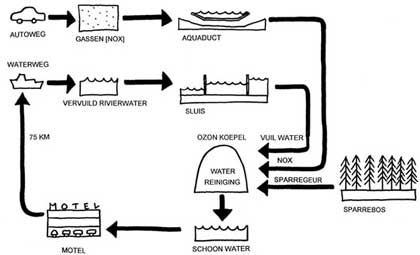 Infra-ecology by Jago van Bergen, Duzan Doepel and Willemijn Lofvers, explores new ways to turn motorways into places for offices and noise pollution into birdsong. Spa-Spar, for example, envisions a motel chain on the crossing of a water- and a highway. Motel rooms with adjacent spa pools would be located above highway and waterway crossings. The system would use the water purification effect of ozone. Ozone is created during the reaction of nitrogen oxide from car exhausts with the fresh smell of pine trees.
Infra-ecology by Jago van Bergen, Duzan Doepel and Willemijn Lofvers, explores new ways to turn motorways into places for offices and noise pollution into birdsong. Spa-Spar, for example, envisions a motel chain on the crossing of a water- and a highway. Motel rooms with adjacent spa pools would be located above highway and waterway crossings. The system would use the water purification effect of ozone. Ozone is created during the reaction of nitrogen oxide from car exhausts with the fresh smell of pine trees.
 Edible Estates invites American families to trade the “carpet of conformity” that is the lawn against food-producing vegetable gardens right in their front yards. Started in 2005 Los Angeles, the concept is spreading to other cities like London and New York. As Fritz Haeg, the organizer of the project, writes the food will connect us to the seasons, the organic cycles of the earth and our neighbors. I used to live in the countryside and enjoying the passing of the seasons is something i’m missing. Seasons to me now are no more than a fashion issue.
Edible Estates invites American families to trade the “carpet of conformity” that is the lawn against food-producing vegetable gardens right in their front yards. Started in 2005 Los Angeles, the concept is spreading to other cities like London and New York. As Fritz Haeg, the organizer of the project, writes the food will connect us to the seasons, the organic cycles of the earth and our neighbors. I used to live in the countryside and enjoying the passing of the seasons is something i’m missing. Seasons to me now are no more than a fashion issue.
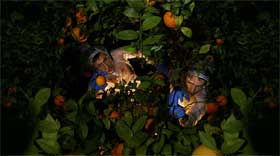 Fallen Fruit asks citizens to map all the “public fruit” planted on private property that overhangs public space. If a fruit tree grows on or over public property, the fruit is legally no longer the sole property of the owner. The fruit maps, photos and essays aim to build up an online global public fruit resource. Besides, Fallen Fruit encourages people to grow fruit on the perimeter of their property and let others harvest it and to petition the cities to plant fruit-bearing trees in public parks. Freegans have adopted an extreme version of the idea: their objective is to remove themselves from participation in the capitalist economy altogether as workers and consumers. Some of them get thus free food by pulling it out of the garbage of restaurants, grocery stores, and other food-related industries.
Fallen Fruit asks citizens to map all the “public fruit” planted on private property that overhangs public space. If a fruit tree grows on or over public property, the fruit is legally no longer the sole property of the owner. The fruit maps, photos and essays aim to build up an online global public fruit resource. Besides, Fallen Fruit encourages people to grow fruit on the perimeter of their property and let others harvest it and to petition the cities to plant fruit-bearing trees in public parks. Freegans have adopted an extreme version of the idea: their objective is to remove themselves from participation in the capitalist economy altogether as workers and consumers. Some of them get thus free food by pulling it out of the garbage of restaurants, grocery stores, and other food-related industries.
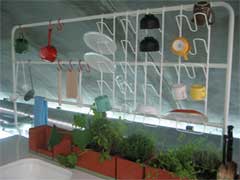 The Kitchen of Terrestrial Mechanics uses natural phenomena such as gravity, evaporation, plant growth, static electricity, decomposition and digestion as mechanical elements for kitchen design. There are of course worms that turn the garbage into composted material but John Arndt also came up with some unexpected ideas such as: water dripping off cleaned dishes falls onto the herbs growing below the dish rack or onto unglazed ceramic food containers to make them cooler.
The Kitchen of Terrestrial Mechanics uses natural phenomena such as gravity, evaporation, plant growth, static electricity, decomposition and digestion as mechanical elements for kitchen design. There are of course worms that turn the garbage into composted material but John Arndt also came up with some unexpected ideas such as: water dripping off cleaned dishes falls onto the herbs growing below the dish rack or onto unglazed ceramic food containers to make them cooler.
For the kitchen to work for you, you must use it. It depends upon you to feed it, water it, let it grow, harvest it, eat it, etc.
Then the exhibition also highlighted some of Debra Solomon’s own projects:
How did people enjoy the experience of eating in a Sproutstaurant?
The Sproutrestaurant was first enjoyed at the Mediamatic exhibition Night Garden for two months starting in November 2006. Guests enjoyed a tasting menu of 31 different sorts of micro greens, sprouts and cresses with three different sorts of potato mash, ginger crackling and onion marmalade. For the meat eaters there were also some pork or lamb additions (all locally produced and organically grown).
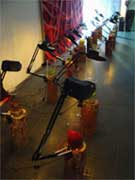
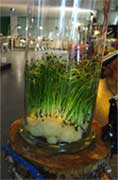
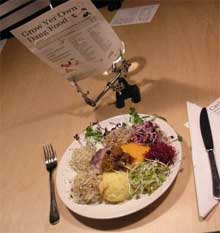 More images at culiblog
More images at culiblog
The layout of the plate suggested that you could try to taste every single sprout with every sort of mash. That would be upwards of 93 variations for those folks that are really anal I mean disciplined, a completely unrealistic desire, in any case. People constantly told me how exciting they found it to eat such a non-homogenous dish, each bite different from the last one and they were amazed to find out that they were capable of growing all of the sprouts at home. I gave a lecture explaining how to sprout and posted this on my blog in the hope that it would be an inspiration. People still write me exclaiming the wonders of the coreander sprout or the sublime perfume of the fennel sprouts.
At the Edible City exhibition, the Grow Yer Own Dang Food Sproutrestaurant will be open during the symposia. In the mean time, the sprouts that we grow in the exhibition will be used as a material by one of the designers to press into wastewear ‘ceramic’ bowls for the special micro-green cuisine that we plan on serving there later in the exhibition.
Can you give me more details about that project you’re working on together with David Barrie and Nina Belk? Has the balcony farming of DOTT07 started already? How is the growing process going on? Which feedback have you received so far from people involved in Tees Valley?
The DOTT07 Urban Farming project will begin cultivation of small, medium and large mobile planters at the start of April. Right now we are in full-on preparation mode working with the local organisations and institutions to make the growing and cooking phases happen. I’ll have to get back to you to tell you how this goes, but I suspect that it will go brilliantly because already we have received more pledges than we can honour for the planters. The city of Middlesbrough has also already decided to keep the planters for the following year, so it is easy to interpret this as a high level of enthousiasm and support for this project. The kitchen playgrounds are the next part of this project that we are addressing – because our team believes that it isn’t enough to just get your hands dirty in the garden, you have to also get your hands dirty in the kitchen. Food sovereignty means ownership of the entire multi-context process of getting food on the table.
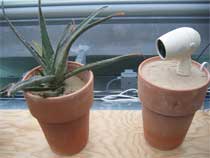
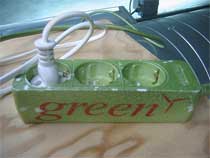 Climate Machine – Ton Matton
Climate Machine – Ton Matton
Are you optimistic about the future of urban environment and its urban food system?
If I look at architectural and urban regeneration projects in Northern Europe that incorporate a food growing element, I am extremely optimistic. Increasingly designers, architects and urban planners are using food growing elements in urban projects because of food’s life enhancing properties, but also because food growing as part of an overall plan for the built environment can increase land value in cities the long term. Aside from the placemaking effects of food producing landscapes in urban areas, food growing spaces are treated with greater care than places in which the landscape architecture is simply decorative. Growing food in the city can transform derelict spaces into places which inhabitants deeply care about. Municipalities are starting to latch onto this idea because they know that its simply good business.
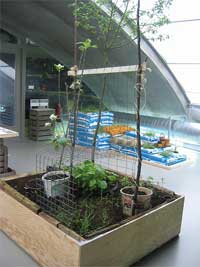 How about the design of the exhibition itself? What guided the way you show the works? Which “trick” did you use to make the whole experience of visiting Edible City more engaging?
How about the design of the exhibition itself? What guided the way you show the works? Which “trick” did you use to make the whole experience of visiting Edible City more engaging?
The curatorial team (Hans Ibelings, Anneke Moors and I) knew that due to the subject matter, the majority of the projects would only be visible in 2D documentation. We thought it might be fun to express how lush the built environment could become through the addition of food production by doing just that in the exhibition itself. For the exhibition design we worked with the Dutch group Event Architecture who in turn brought in the growing expertise of de Groene Stap (the Green Step) to produce a lush and edible experience in the exhibition space itself. We also intend to keep the exhibition engaging by planning some symposia during the harvest period of this season’s vegetables and soft fruit in June. I’ll certainly keep you posted when we nail down the dates for these events.
Thanks Debra!
Edible City is running at the Netherlands Architecture Institute in Maastricht (NL) until June 22.
